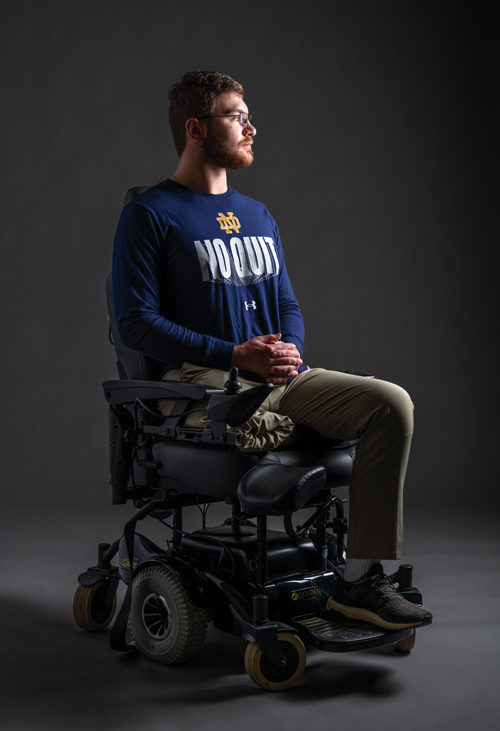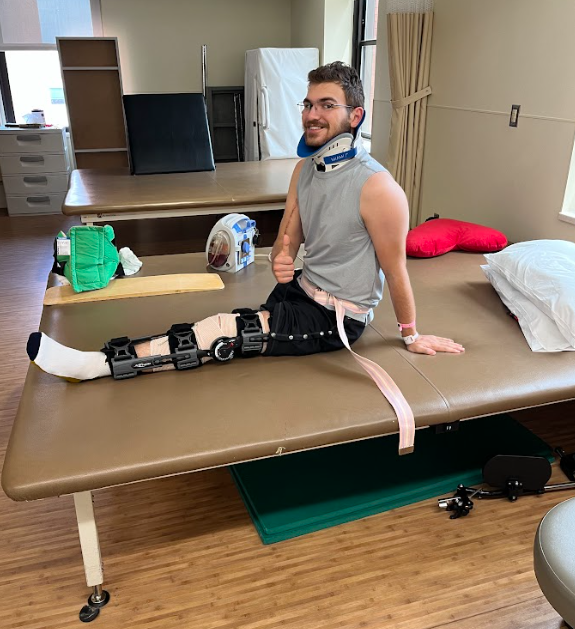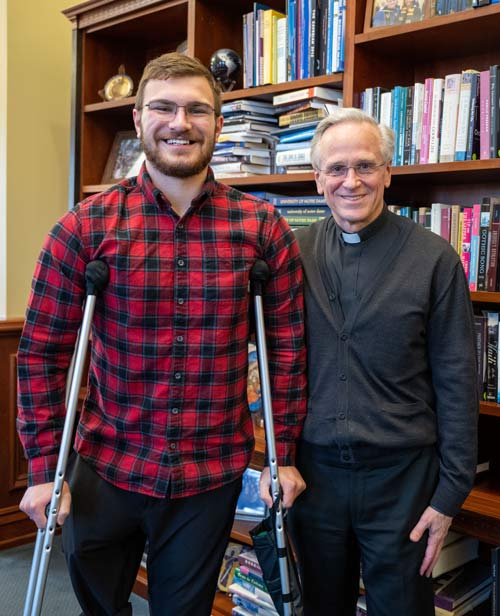REMARKABLE RECOVERY
Spring 2023
Junior Andrew Daigneau bounces back from traumatic motorcycle accident
Notre Dame junior Andrew Daigneau has always loved speed — fast cars and motorcycles. He loves to tinker with both and has bought and fixed about a dozen, selling some.
But he’s positive he wasn’t speeding on his motorcycle after perusing the hot rods at a car show with family and friends. It was a warm June night last summer in his hometown of South Bend. His father, Judd Daigneau, was riding next to him on his own bike.
Leaving the car show, Andrew gave his father a fist bump before he headed off in the other direction. It’s the last thing he can remember.
 “Most of my account is what I’ve heard from other people, because due to the shock and head trauma, there’s like three weeks that are just gone,” he said.
“Most of my account is what I’ve heard from other people, because due to the shock and head trauma, there’s like three weeks that are just gone,” he said.
His girlfriend was driving a car closely behind him about a mile from campus when a Dodge Journey swerved across Andrew’s path. He braked and tried to turn, but it was too late. His bike hit the car and propelled him forward. His chin may have smashed into the roof, just below his full-face helmet. The impact folded his jaw through his mouth and toward one ear.
“I broke 15 teeth,” he said. “I had a traumatic brain injury. I broke my neck in three places. Top two ribs broken. My sternum. This arm was an open fracture.”
Pointing to a scar, he continued: “That’s where the humerus [bone] came out, and I’ve got four plates and a bunch of screws in that one. I broke my hip and pelvis, I broke this [left] tibia, and I tore everything in the knee ... and then this leg was very bad.”
A business major, he recounts this list with a notable lack of drama in an office in Mendoza College of Business in late October. As bad as the list sounds, his injuries were actually much worse.
The femoral artery and nerve of his right leg had been severed, and he could have bled out if not for the fast action on the scene from paramedics and doctors at Beacon Memorial Hospital. His heart stopped for about 10 minutes. Even though the human body only holds five liters of blood, Andrew required 19 liters to save his life that night.
His father said it’s a good thing Andrew can’t remember because he went through half a day of hell. First, the chaplain told the parents about his heart stopping and said they should prepare themselves for the worst.
Then the surgeons told them that they couldn’t give Andrew pain medicine because it would lower his blood pressure, which was already too low and threatening to crater again. For 12 hours, every time he would gain consciousness, the pain would be so great he would pass out again.
“That’s tough to watch as a father,” Judd recalled. “The surgeons came to tell us, ‘Andrew’s hurt real bad. It’s going to be very touch and go.’ But in order to save his life, they were going to have to amputate his leg.”
Other Perspectives
Judd Daigneau, a pilot, had driven his own motorcycle home after the car show when he got the call about Andrew’s accident. He rushed back to the scene in time to see his son loaded onto the ambulance. He saw a family friend, Eric Beckham, a Mishawaka police captain who had stopped to help.
“I’m like, ‘Eric, that’s Andrew,’ and his face just goes white,” Judd said. “He’s known Andrew since fourth grade. He was his football coach and mentor.”
Beckham said he doesn’t usually go to accident scenes because there are so many, but he heard fear in the voice of the first officer to arrive.
“Where Andrew was laying, I saw his helmet and some gloves and a trail of blood,” Beckham said. “There are times when I’ve had to deal with emergencies in my own family, and it gave me that same eerie feeling.” At the hospital, Beckham saw a doctor reaching inside Andrew’s leg to hold his ruptured artery and slow the bleeding while calling for an intensive care room. One of the medics that Beckham knew well said that Andrew died once in the room but they were able to revive him.
The doctors had started the amputation when his blood pressure began to drop. “Once they actually completed the amputation,” Judd said, “all his vitals started increasing very rapidly because his body was trying to devote so many resources towards this injury that it was actually killing him, and that’s the way the doctors explained to us.”
The registered nurses in intensive care took to Andrew immediately. Teresa Cesavice, a motorcycle rider with a son Andrew’s age, traded shifts to be with him for 10 days straight.
“I usually work four shifts a week and I don’t pick up an extra because after that, I’m tired,” Cesavice said. “But he was one of those kids that touched me — he and his family. I didn’t want to leave, because if you take a day off, you’re not guaranteed to get your patients back.”
Rude Awakening
After those 10 days, Judd knew his son would soon be awake enough to learn the truth about his lost leg.
Andrew listened calmly, though the shock visibly rolled through his body. A surgeon gave the medical explanation. Andrew raised his hand. The doctor didn’t understand, so Judd told him Andrew wanted to give him a fist bump to say thanks.
 “Apparently the first night, I took it very rough,” Andrew said. “I don’t remember that one. But I came to terms very quickly with it. As I learned more about everything that happened, I was like, ‘I completely understand the decision.’”
“Apparently the first night, I took it very rough,” Andrew said. “I don’t remember that one. But I came to terms very quickly with it. As I learned more about everything that happened, I was like, ‘I completely understand the decision.’”
Around that time, he was transferred to the pediatric ICU to allow more space in the adult unit. Nurse Heather Berry took care of him there.
“Even though I had heard about his injuries, it almost wasn’t real,” Berry said. “Here’s this healthy 20-year-old man just kind of helpless. It was a bit personal because I have a son who’s an athlete, and I thought about what this would have done to my son.”
Berry finally heard Andrew speak on his last day in her care, but she could already tell from his patience how resilient he was.
“His case reminded me of why I do what I do,” Berry said. “I was in a position where I didn’t know if I wanted to keep doing this. And it kind of renewed that passion in me, like maybe I really am making a difference.”
Andrew said he lost count of the number of surgeries at around 16. For three months, he could only eat liquids. Blended waffles and syrup for breakfast. Shakes and blended food for dinner. He lost significant weight, on top of the lost leg. Visitors often brought gifts of food he could only stare at.
The doctors said he may not be able to stand up and crutch around for a year. Some thought he might have to go away to a full-time rehabilitation facility.
His actual progress shocked everyone but those close to him. He told his family that he wanted to return to Notre Dame in the fall, and that he planned to graduate with his classmates.
“I have no doubt in my mind that he’s going to end up walking across the stage for graduation,” said his girlfriend, Madison Boothe, who pushed him out of the hospital a month after she went there with him.
The Road Back
At vocational rehab, Andrew said he learned that most people with his level of brain trauma never return to work. But one of his first questions after fully waking up was, “What about Notre Dame?”
 Judd said Andrew received visits from Notre Dame well-wishers, from priests and staff to Mendoza Dean Martijn Cremers. “The way Notre Dame has surrounded Andrew and us has been amazing,” he said. “It’s been heartwarming to say the very least.”
Judd said Andrew received visits from Notre Dame well-wishers, from priests and staff to Mendoza Dean Martijn Cremers. “The way Notre Dame has surrounded Andrew and us has been amazing,” he said. “It’s been heartwarming to say the very least.”
Andrew Wendelborn, assistant dean of Undergraduate Studies at Mendoza, said he first met Andrew in the hospital in July. By August, Wendelborn said Andrew made it clear that he wanted to return to classes part time, which is not usually allowed.
“I felt not allowing him would be detrimental to his recovery,” Wendelborn said. “He was beating doctors’ deadlines. I wrote a note on his behalf and said I wish I could bottle his spirit and share it with other students and people who struggle. It’s a positivity and hope and joy I can’t say I’ve seen very often.
“He’s in the first cohort of the Business Honors Program. The reason I pushed to get him part time was for himself, but I also wanted his cohort to see what he’s doing, so he could rub off on them.”
Despite having a surgery on the first class day and an average of two doctors’ appointments every day, Andrew took seven credits in the fall semester while living at his parents’ home. By October, he was driving himself to school in a van that could accommodate his wheelchair. He was fitted for a prosthetic leg in November. It includes a computer with different modes that can be changed on a cell phone — for walking, riding a bike and other activities with different bending needs. Using parallel arm bars, Andrew practiced walking for the first time in five months.
On December 1, he drove to school and directed his motorized wheelchair to an office in Mendoza, where he parked the chair and switched to crutches. He took the elevator to the third floor and maneuvered into his seat in the back corner of Foundations of Marketing. He flipped his prosthetic leg in a circle and told a classmate it was his new party trick.
Andrew said the silver lining of losing his leg has been meeting a whole new community of remarkable people. He was introduced to a weightlifting champion with one leg. He joined a group playing wheelchair basketball.
He’s already noticed that he can inspire others, too. “It’s going to be an uphill battle, especially as I get my prosthetic and learn how much harder it is to do some of the things I used to do,” he said. “But I can just impact people in a way now that I couldn’t before. I think that’s what helps me keep going along, is seeing other people smile and motivated to see me doing well.
Full Return
In mid-December, Andrew returned to the spot where the accident happened. A believer in cold weather acclimation, he wore a T-shirt and shorts and used a crutch to point to where his motorcycle collided with the car. He displayed the helmet he was wearing, which was far less scratched and broken than his body.
 A month later, Andrew drove to a bi-weekly physical therapy class at Memorial Outpatient Services. Jennifer Cunningham, a therapist, helped him into a harness that prevents him from falling as he practices walking without any crutches for the first time.
A month later, Andrew drove to a bi-weekly physical therapy class at Memorial Outpatient Services. Jennifer Cunningham, a therapist, helped him into a harness that prevents him from falling as he practices walking without any crutches for the first time.
The motion is jerky, tiring and painful, especially to the skin where his leg was amputated. Even with a lining at the connection, it takes time and repetition to accustom the residual tissue to a heavy load it wasn’t designed to bear. Above-knee amputees use 50% to 75% more energy than other people. Andrew rests when “what’s left of my hamstring is trying to cramp.”
To make up for his part-time semester, Andrew signed up for seven classes in the spring, two more than the normal load. They range from Investment Theory to Schooling, Self and Society.
“I’m basically pre-law, but this has definitely changed my perspective because I’ve got a new respect for the medical field since I had my life saved,” he said. “I know there’s a joint MBA and JD program here where you can get both in three years, so then I could use the law to benefit the medical field.”
Despite progress, this semester included some steps backward as well. At the end of January, he had another jaw surgery for replacement teeth implants that necessitated a month-long return to the liquid food diet. Over spring break, he was scheduled for a shoulder surgery, as well as another elbow surgery before finals.
This summer, he plans to volunteer in the Wearable Robotics Lab with Edgar Bolívar-Nieto, a Notre Dame professor of aerospace and mechanical engineering. The lab researches motion control and prostheses, developing software and hardware prototypes that can perceive the desires of prosthetic users and provide powered assistance. Bolívar-Nieto met Andrew at an amputee support group and thought he would be a perfect test case.
“Andrew is an excellent candidate given that he is very active,” Bolívar-Nieto said. “He has a state-of-the-art prosthesis, but it can be improved. Those processes are passive, so they don’t have mechanical energy to support you when you stand up, when you go upstairs. There are some challenges we hope to overcome with our prosthesis and control algorithms.”
Andrew is excited about the future of prosthetic technology, and he will help make some of the advances a reality.
“I’m very hopeful because I recognize 20 or 30 years from now, technology is going to be light-years ahead of where it is today,” he said. “No, it will never truly replace a leg, but I’m confident I’ll get a lot of my life back.”
Photos by Barbara Johnston.

Comments